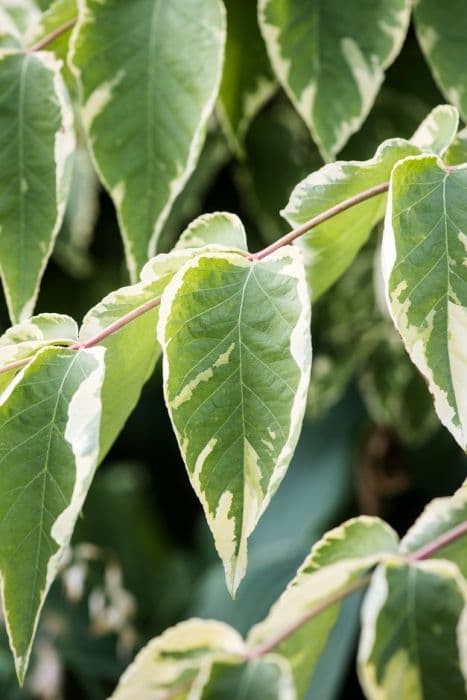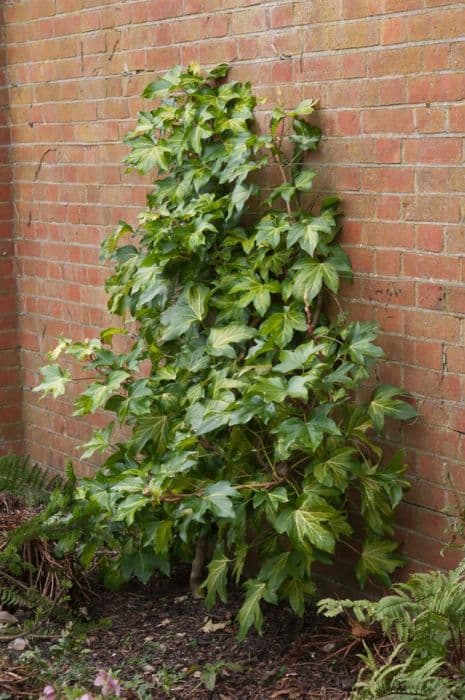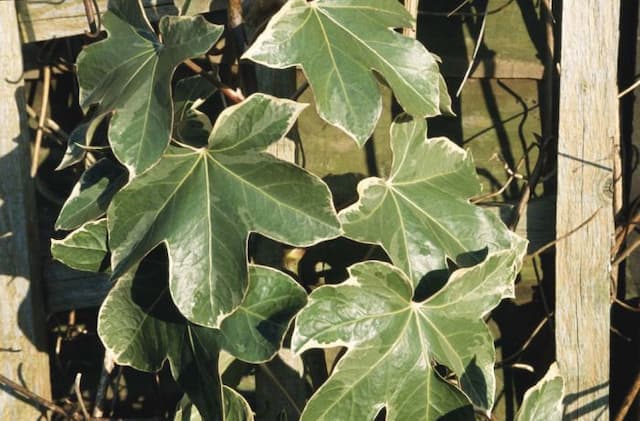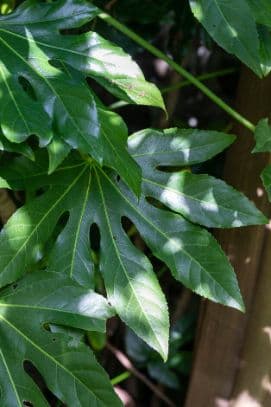Taiwan Fatsia Fatsia polycarpa

ABOUT
Fatsia polycarpa, more commonly known as the Taiwanese fatsia, is an evergreen shrub known for its ornate and tropical appearance. The plant stands out with its glossy, dark green leaves that have a palmate shape, meaning they spread out like fingers with several lobes radiating from a central point. These leaves are quite large and leathery to the touch, often giving the foliage a lush, dense look. Each leaf is connected to the main stems by a long petiole, which allows the leaves to elegantly droop, creating a striking visual profile. During its blooming period, the Taiwanese fatsia produces clusters of small, white flowers. These flowers are spherically shaped, somewhat similar to little pompoms, and they are held together in a compound inflorescence called an umbel. Once the flowers have been pollinated, they give way to small, round fruits that are not commonly eaten. The general impression of the Taiwanese fatsia is one of a robust and extravagant plant with a knack for drawing the eye, thanks to its rich foliage and distinctive flowering structures. Its lush leaves grant it a tropical flair, often making it a favorite for those looking to add a touch of exuberance to their garden or as an interior houseplant.
About this plant
 Names
NamesFamily
Araliaceae
Synonyms
Taiwanese Aralia, Needle-leaved Paper Plant
Common names
Aralia polycarpa, Panax polycarpus, Fatsia oligocarpella.
 Toxicity
ToxicityTo humans
The Fatsia polycarpa, commonly known as the Taiwanese fatsia, is not widely recognized for high toxicity to humans. However, like many houseplants, it could cause discomfort if ingested. It is important to handle plants with care and wash hands afterwards, as some people might experience skin irritation from contact. Ingesting parts of the plant may result in gastrointestinal distress, such as nausea, vomiting, or diarrhea. It is always advisable to keep plants out of reach of children and to avoid ingesting plant material.
To pets
The Taiwanese fatsia, or Fatsia polycarpa, is not known to be highly toxic to pets, but it can still cause mild to moderate gastrointestinal upset if ingested. Symptoms of poisoning may include vomiting, diarrhea, drooling, or lack of appetite. As pets' reactions can vary widely, it is best to err on the side of caution and prevent your pets from chewing on or consuming any part of the plant. If you suspect your pet has ingested part of a Taiwanese fatsia and is showing symptoms, consult a veterinarian.
 Characteristics
CharacteristicsLife cycle
Perennials
Foliage type
Evergreen
Color of leaves
Green
Flower color
White
Height
10 feet (3 meters)
Spread
10 feet (3 meters)
Plant type
Shrub
Hardiness zones
8
Native area
Taiwan
Benefits
 General Benefits
General Benefits- Aesthetic appeal: Fatsia polycarpa, commonly known as Taiwanese fatsia, is an ornamental plant with large, glossy leaves that add a tropical look to gardens.
- Shade provision: Its dense foliage provides shade and can help in creating cool, shaded areas in gardens or patios.
- Ease of care: Taiwanese fatsia is known for being relatively easy to care for, making it a good choice for novice gardeners.
- Privacy screen: With its robust growth, it can be used to create a natural privacy screen or hedge.
- Habitat support: The plant can provide habitat for wildlife, such as birds that might nest among its leaves and branches.
- Soil stabilization: Fatsia polycarpa can help in stabilizing soil and preventing erosion in garden settings with its root system.
 Medical Properties
Medical PropertiesThis plant is not used for medical purposes.
 Air-purifying Qualities
Air-purifying QualitiesThis plant is not specifically known for air purifying qualities.
 Other Uses
Other Uses- Fatsia polycarpa's large leaves can be used in floral arrangements to provide a lush, tropical backdrop for other flowers, enhancing the overall aesthetic of a bouquet.
- The stems of Fatsia polycarpa can be used in the construction of small crafts or as natural stakes for supporting other plants in the garden.
- Dried Fatsia polycarpa leaves can be used to create eco-friendly, biodegradable plates or platters for serving food at outdoor events.
- Leaves of Fatsia polycarpa can be used as natural wrappers for cooking, in a similar manner to banana leaves, imparting a subtle flavor to steamed dishes.
- The fibrous parts of Fatsia polycarpa can be utilized in the creation of handmade paper, contributing to its texture and durability.
- Fatsia polycarpa's dense foliage can provide privacy in a garden setting when planted in a group, acting as a living screen or hedge.
- As a resilient and easily propagated plant, Fatsia polycarpa can be used in reforestation projects or for erosion control on slopes and banks.
- Fatsia polycarpa can be grown indoors in large containers as a statement piece due to its bold foliage and architectural presence.
- The plant's seeds can be used as an ingredient in bird feed, providing a natural food source for wildlife in the garden.
- Fatsia polycarpa, with its thick foliage, can create microhabitats for small wildlife, offering shelter and a humid environment for insects and small birds.
Interesting Facts
 Feng Shui
Feng ShuiThe Fatsia is not used in Feng Shui practice.
 Zodiac Sign Compitability
Zodiac Sign CompitabilityThe Fatsia is not used in astrology practice.
 Plant Symbolism
Plant Symbolism- Resilience: Fatsia polycarpa, known as needles to its ability to thrive even in challenging conditions, symbolizing endurance and the power to overcome difficulties.
- Growth and Expansion: The wide-spreading leaves of the needles plant resonate with the idea of expansion and reaching outwards in one’s life, suggesting personal growth and the desire to broaden one’s horizons.
- Protection: In some cultures, the dense foliage of the needles plant is thought to offer protection and is used in homes to shield against negative energies, symbolizing a safe and secure environment.
- Prosperity: Given its lush and vibrant appearance, the needles plant is often associated with wealth and prosperity, symbolizing an abundance in one's life or business endeavors.
 Water
WaterThe Taiwanese fatsia should be watered when the top inch of soil feels dry to the touch. Generally, this could be about once a week, but you'll need to adjust depending on temperature and humidity. The goal is to keep the soil evenly moist, but not soggy. When watering, provide enough water so that it runs through the drainage holes at the bottom of the pot - this could be approximately half a gallon for a medium-sized pot every watering session. Decrease watering frequency in the winter when plant growth naturally slows.
 Light
LightThe Taiwanese fatsia thrives in bright, indirect light. A north-facing window or a spot that receives filtered light through sheer curtains is ideal. Avoid direct sunlight, especially in the hot afternoon hours, as it can scorch the leaves. If natural light is limited, placing it near a grow light can also suffice.
 Temperature
TemperatureThe Taiwanese fatsia prefers a temperature range between 60 and 75 degrees Fahrenheit. It can survive minimum temperatures down to about 50 degrees Fahrenheit, but growth can be affected. Avoid placing the plant in areas with drafts, sudden temperature changes, or near heating and cooling vents.
 Pruning
PruningPruning the Taiwanese fatsia is necessary to maintain its shape and encourage bushier growth. Prune in the spring before the new growth begins, cutting back any leggy stems or dead leaves. It's usually sufficient to prune once a year, but you can also do light pruning throughout the year to remove any damaged or yellowing leaves.
 Cleaning
CleaningAs needed
 Soil
SoilThe best soil mix for Taiwanese Fatsia should be well-draining and rich in organic matter. A mixture of potting soil, coarse sand, and peat or compost at a ratio of 2:1:1 can be ideal. The soil pH should range from 5.5 to 6.5 to ensure proper nutrient uptake.
 Repotting
RepottingTaiwanese Fatsia should be repotted every 2 to 3 years or when rootbound. Repotting in spring allows the plant to recover and grow during the active growing season.
 Humidity & Misting
Humidity & MistingTaiwanese Fatsia thrives in moderate to high humidity levels, ideally between 60% to 75%. It can tolerate lower humidity but might require regular misting to maintain its health.
 Suitable locations
Suitable locationsIndoor
Place Taiwanese Fatsia in bright, indirect light and keep soil moist.
Outdoor
Locate Taiwanese Fatsia in partial shade with shelter from strong winds.
Hardiness zone
8-10 USDA
 Life cycle
Life cycleThe life cycle of Fatsia polycarpa, commonly known as the Taiwanese fatsia, begins with germination, where seeds require warm, moist conditions to sprout. Following germination, the seedling stage involves initial growth of roots and shoots until enough foliage is present to begin photosynthesis. As the plant enters the vegetative stage, it experiences rapid growth and the development of characteristic features like its large, glossy, palmate leaves. The mature plant then reaches the flowering stage, typically in late autumn or winter, producing white, globular flower clusters that attract pollinators. After pollination, the flowers develop into small black fruits, each containing seeds that can disperse to give rise to new plants. Throughout its life, the plant will go through cycles of growth and dormancy, responding to seasonal changes in temperature and light.
 Propogation
PropogationPropogation time
Spring-Early Summer
Propogation: The Fatsia polycarpa, commonly known as Taiwanese Fatsia, is typically propagated through semi-ripe cuttings during late summer to early autumn. To propagate by this method, a cutting of about 4-6 inches in length (10-15 cm) is taken from the parent plant, which includes a small portion of older wood at the base. The lower leaves are removed, and the base of the cutting is dipped in rooting hormone to encourage root development. This cutting is then planted in a well-drained soil mix and kept in a warm, humid environment, out of direct sunlight. Rooting usually occurs within a few weeks, after which the new plant can be transferred to a larger pot or to its final growing location. Proper care should be taken to ensure that the cutting does not dry out during the rooting process.









